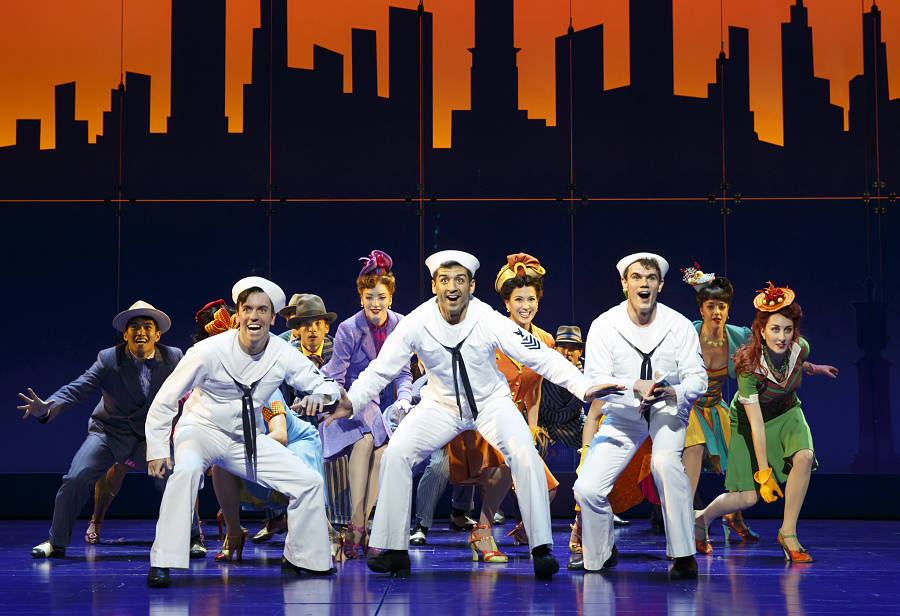Surrender—that’s what I’d call the most significant phase in my lifelong on-again, off-again love affair with the musical. I was a film student at USC, in the midst of my discovery that I preferred watching and arguing about movies to making them, and it was around the time I took a lark of a class on film musicals, taught by the inimitable ex-Jesuit sage Drew Casper, that it dawned on me: It’s okay to enjoy what I’m enjoying. I remember the sensation as feeling a bit like I was standing outside myself and saying: “Look, chump, your brain is telling you this big tap number is silly, but you’re smiling—in fact, you’ve been smiling uncontrollably for a straight hour.”
The takeaway: The involuntary inward grin raised by a beautifully executed dance sequence, a giddy patter song, a torchy 11 o’clock number—I could own this pleasure as more than a guilty one. This was genuine aesthetic, even spiritual pleasure, as rich and soul-lifting as any I got from Mozart or Shakespeare, or Westerberg or Whedon or Weill.
Up to that point I’d taken musicals for granted, I guess. I’d done a few in high school, worn out a few old records in my childhood (you should have seen my 10-year-old bottle dance), but, as with many fixtures of youth—religion, polyester, Saturday morning cartoons—it was unlikely to last into adulthood unless I could find my own way in. In films like Singin’ in the Rain, The Band Wagon, Meet Me in St. Louis, and Easter Parade, I found my bliss again.
Musical theatre was a whole nother thing, though. At the time I was having my musicals-are-art-too epiphany—a realization based, crucially, on dance-heavy, tailored-for-film classics by Vincente Minnelli and Stanley Donen, not stage-to-film white elephants mounted by the likes of Robert Wise—the American stage musical was in a bit of a doldrums, still limping in the shadow of Cameron Mackintosh. A few things happened to reconcile me, in my own idiosyncratic way, to the stage tuner: I joined an L.A. offshoot of the famous BMI Lehman Engel Musical Theatre Workshop as a composer/lyricist, which immersed me in the form in a hands-on way (last I checked, I’m still a member of the New York original); I started seeing great productions of Sondheim musicals in small (and not so small) L.A. theatres, leading me to realize that the form could also be ambitious, thorny, uncompromising—in short, could offer forms of theatrical pleasure apart from warmth and smiles; and Ragtime had its U.S. debut in L.A. Repeated viewings have slightly dimmed my estimation of that landmark Flaherty/Ahrens epic, but at the time it seemed like overdue confirmation that the stage musical could do and say anything—that the form birthed by Show Boat was still going full steam.
Around the same time, the phenomenon of Rent was convincing many people that the musical could speak to the present, as well as look and sound (roughly) like the present. I was never sold on Rent, though I appreciate it now as a period piece (in much the same sidelong way I view much of the sung-through bombast of the Phantom/Miss Saigon ’80s), and I’m especially grateful for the galvanizing influence it had on artists like Lin-Manuel Miranda. The other thing that’s happened in the last few decades is that, alongside the growth of new-play development programs both within and outside the nation’s nonprofit theatres, there has been a concerted effort to nurture new generations of musical-theatre talent, from Palo Alto to Poughkeepsie. And the new generations have flooded in, some bringing their bands with them, others uploading their efforts directly to the Internet.
I’m especially pleased, though, that for all the great new work that’s reaching the stage and finding huge new audiences (you may have heard of this thing called Hamilton), there is no shortage of interpreters who know how to break it down old-school. Indeed, among the best things I’ve ever seen on a stage, and which I visited again last week for the third time, is the current revival of On the Town, a companionable bit of WWII-era froth with a killer Bernstein score that’s being given as perfect a rendering, under director John Rando and choreographer Joshua Bergasse, as I can imagine. (And lead Tony Yazbeck can join any triple-threat pantheon you care to build.) As I’ve written elsewhere, it’s the closest any stage musical I’ve seen has come to the unrefined sugar-high joy of mid-century MGM musicals like Singin’ in the Rain or The Band Wagon.
Clearly, my surrender to the musical was never unconditional, but as long as there are both new and like-new musicals this good reaching the stage, I’ll be smiling uncontrollably for many hours to come.


